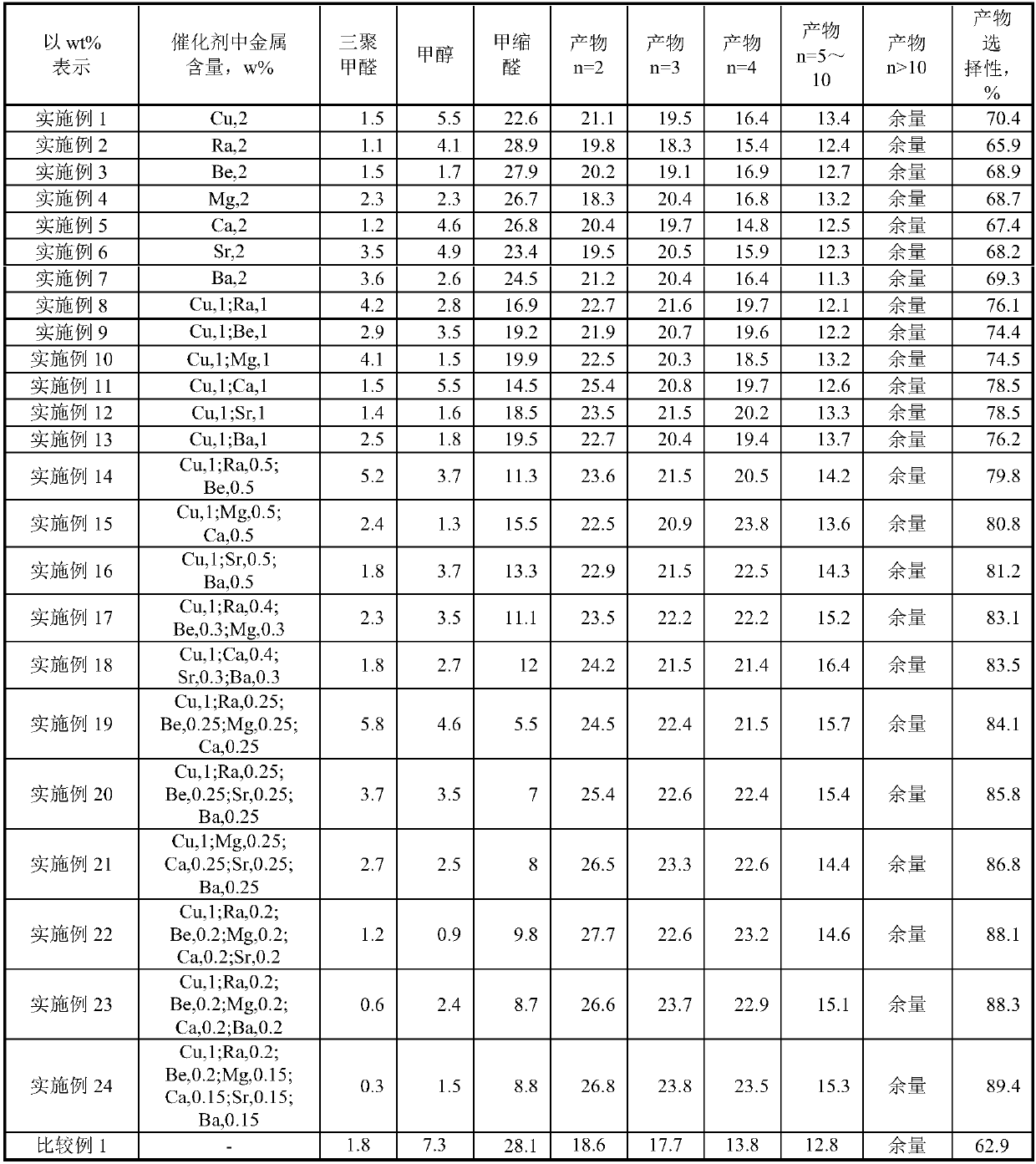Production method of PODE (polyoxymethylene dimethyl ethers)
A technology of polyoxymethylene dimethyl ether and paraformaldehyde, applied in chemical instruments and methods, preparation of organic compounds, organic compound/hydride/coordination complex catalysts, etc., can solve the problem of low product selectivity and achieve The effect of good yield and good technical effect
- Summary
- Abstract
- Description
- Claims
- Application Information
AI Technical Summary
Problems solved by technology
Method used
Image
Examples
Embodiment 1
[0030] 1. Preparation of catalyst
[0031] Sodium sulfonate type polystyrene cation exchange resin 7320 is washed with deionized water until clear water flows out, then soaked four times with 4w% hydrochloric acid, each use is equivalent to 10 times the dry weight of sodium sulfonate type polystyrene cation exchange resin 7320 4w% hydrochloric acid, soaked for 4 hours each time, then washed with deionized water until the eluate was free of chloride ions, and dried at 60°C to obtain a sulfonic acid polystyrene cation exchange resin with a total exchange capacity of 4.10 mmol / g. Get the sulfonic acid type polystyrene cation exchange resin that is equivalent to dry base resin 98 grams and 300ml contain Cu and be 2 grams of Cu(OH) 2 The aqueous suspensions were mixed, 1 drop of glacial acetic acid was added, mixed, left standing at room temperature for 24 hours, and dried in a vacuum drying oven to a constant weight to obtain a catalyst with a Cu content of 2w%.
[0032] 2. Synt...
Embodiment 2
[0035] 1. Preparation of catalyst
[0036] Sodium sulfonate type polystyrene cation exchange resin 7320 is washed with deionized water until clear water flows out, then soaked four times with 4w% hydrochloric acid, each use is equivalent to 10 times the dry weight of sodium sulfonate type polystyrene cation exchange resin 7320 4w% hydrochloric acid, soaked for 4 hours each time, then washed with deionized water until the eluate was free of chloride ions, and dried at 60°C to obtain a sulfonic acid polystyrene cation exchange resin with a total exchange capacity of 4.10 mmol / g. Get the sulfonic acid type polystyrene cation exchange resin equivalent to 98 grams of dry base resin, under nitrogen protection, be 2 grams of Ra(OH) with 300ml containing Ra 2 Mix the aqueous suspensions, add 1 drop of glacial acetic acid, mix, let stand at room temperature for 24 hours, and dry to constant weight in a vacuum oven to prepare a catalyst with an Ra content of 2w%.
[0037] 2. Synthesis...
Embodiment 3
[0040] 1. Preparation of catalyst
[0041] Sodium sulfonate type polystyrene cation exchange resin 7320 is washed with deionized water until clear water flows out, then soaked four times with 4w% hydrochloric acid, each use is equivalent to 10 times the dry weight of sodium sulfonate type polystyrene cation exchange resin 7320 4w% hydrochloric acid, soaked for 4 hours each time, then washed with deionized water until the eluate was free of chloride ions, and dried at 60°C to obtain a sulfonic acid polystyrene cation exchange resin with a total exchange capacity of 4.10 mmol / g. Get the sulfonic acid type polystyrene cation exchange resin equivalent to 98 grams of dry base resin, under nitrogen protection, be 2 grams of Be(OH) with 300ml containing Be 2 Mix the aqueous suspensions, add 1 drop of glacial acetic acid, mix, let stand at room temperature for 24 hours, and dry to constant weight in a vacuum oven to prepare a catalyst with a Be content of 2w%.
[0042] 2. Synthesis ...
PUM
 Login to View More
Login to View More Abstract
Description
Claims
Application Information
 Login to View More
Login to View More - R&D
- Intellectual Property
- Life Sciences
- Materials
- Tech Scout
- Unparalleled Data Quality
- Higher Quality Content
- 60% Fewer Hallucinations
Browse by: Latest US Patents, China's latest patents, Technical Efficacy Thesaurus, Application Domain, Technology Topic, Popular Technical Reports.
© 2025 PatSnap. All rights reserved.Legal|Privacy policy|Modern Slavery Act Transparency Statement|Sitemap|About US| Contact US: help@patsnap.com

